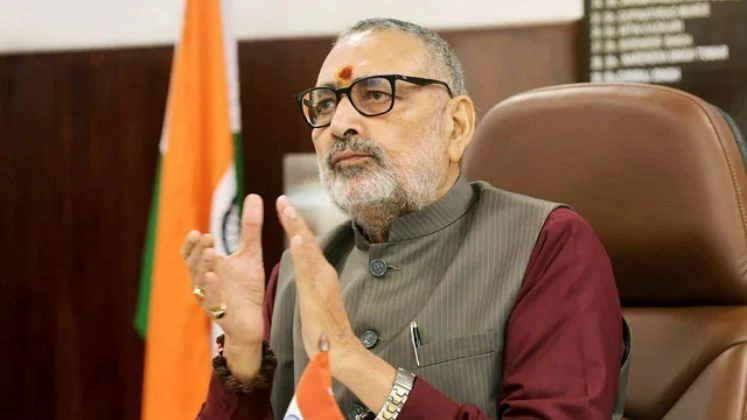US Tariffs Squeeze Indian Textile Industry: Govt Calls Urgent Meeting with Exporters
The Indian textile and apparel industry, a cornerstone of the country’s export economy, is facing one of its toughest challenges in recent years. Following the United States’ decision to impose a 25% reciprocal tariff on Indian textile and apparel imports from August 7—set to rise further to 50% by August 27—exporters are feeling the heat.

In response, the Ministry of Textiles, led by Union Minister Giriraj Singh, has convened an urgent meeting with major exporters from across the country. The objective is to assess the damage, listen to industry concerns, and strategize possible countermeasures.
Why This Tariff Shock Matters
The textile and apparel industry is labour-intensive and heavily dependent on exports, with the US serving as India’s largest single market. This sector employs millions of workers, many from rural and semi-urban areas.
The sudden tariff hike has created pricing disadvantages for Indian exporters compared to other Asian competitors like Vietnam, Bangladesh, and Cambodia, who currently enjoy more favorable trade agreements with the US.
Buyers in the US are reportedly demanding that Indian exporters absorb part of the tariff cost, making already tight profit margins nearly impossible to sustain.
Timeline of the Tariff Increase
- August 7, 2025: US imposes a 25% tariff on Indian textile and apparel imports.
- August 27, 2025: Tariff scheduled to rise further to 50%, unless a breakthrough occurs in trade negotiations.
This steep increase is part of a broader escalation in trade tensions between India and the Trump administration, which has recently introduced tariffs on multiple Indian goods as a response to what it calls “imbalanced trade practices.”
Impact on Export Orders
Industry insiders report that order flows have slowed dramatically since the tariff announcement. Many buyers are pausing orders, waiting for clarity on whether a trade deal might reduce or eliminate the tariffs.
For exporters, this uncertainty is damaging:
- Cash flows are drying up, with factories running below capacity.
- Seasonal orders for the upcoming US holiday season are at risk of being lost entirely.
- Smaller exporters, who lack financial reserves, face the threat of closure and layoffs.
Government’s Role & Exporters’ Demands
At today’s meeting, exporters are expected to put forward several urgent demands:
- Financial Relief: Temporary subsidies or tax rebates to offset the loss of competitiveness.
- Alternative Market Support: Help in identifying and expanding into non-US markets.
- Faster Trade Negotiations: Diplomatic push to resolve the dispute before the second tariff hike.
Union Minister Giriraj Singh is reportedly open to providing short-term support measures, but exporters are emphasizing the need for long-term policy stability.
Wider Economic Implications
This tariff battle is not just about textiles—it’s a signal of strain in India-US trade relations. With the textile industry accounting for a significant share of India’s merchandise exports, the economic ripple effects could extend to:
- Job losses in rural and semi-urban manufacturing hubs.
- Reduced foreign exchange earnings from exports.
- Slowdown in related industries, including cotton farming, dyeing, and logistics.
Competing Asian Nations Gain Ground
While India grapples with tariffs, competitors like Vietnam and Bangladesh are benefiting from preferential trade agreements with the US. Their exporters can now offer more competitive prices to American buyers, potentially capturing market share from India.
This shift could be long-lasting—once buyers shift sourcing contracts, they may not return quickly even if tariffs are later reduced.
What’s Next?
Negotiations between India and the US are ongoing, but diplomatic breakthroughs are uncertain. If the August 27 tariff hike to 50% goes ahead, the impact on India’s textile industry could be severe and prolonged.
Industry experts suggest three immediate strategies:
- Diversifying export markets beyond the US.
- Moving up the value chain by producing higher-end, design-intensive garments.
- Exploring regional trade agreements with tariff advantages.
However, these are long-term adaptations—for now, the sector needs urgent relief to weather the storm.
Weaving a Way Forward
The US tariff escalation has put India’s textile industry in a high-pressure situation. With margins squeezed, orders stalled, and workers’ livelihoods at stake, the coming weeks will be crucial. The government’s ability to negotiate effectively and provide interim relief will determine whether the sector can recover—or lose ground permanently to international competitors.
India’s textiles have long been a symbol of craftsmanship and resilience. But in today’s global trade arena, survival may depend as much on diplomacy and policy agility as on weaving skills.
Follow us for more news at Valleynewz.com

